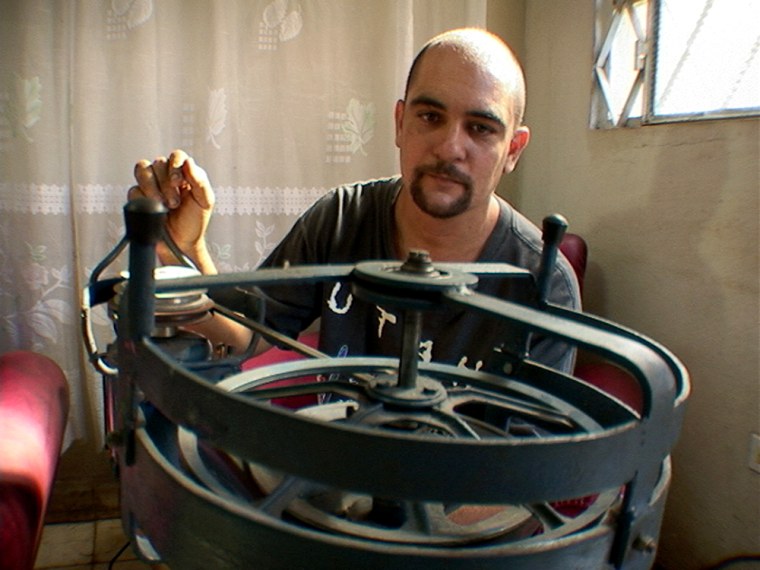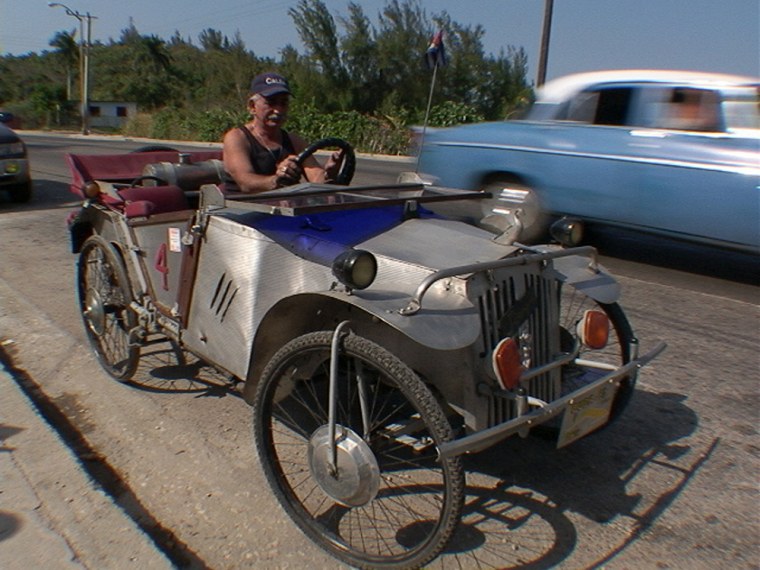Necessity is said to be the mother of invention but it almost sent this mom to an early grave.
One night, my teenage daughter and her friend were primping to go out when I found them rifling through a cardboard box stuffed with Chinese “Twin Lotus” condoms.
My heart stopping, my daughter pulled out a pair of scissors and began cutting them into strips. “Relax, Mom. We’re making Cuban rubber bands. I’m going to braid my hair.”
Cubans calls this “Inventando” — finding clever substitutes to life’s everyday shortages.
Days of the ‘fat cow’ long gone
An expectant father pulled apart an old sofa and used the wooden frame to make a crib. Another parent made her child’s birthday piñata from scraps of newspapers, recycled aluminum foil and wrapping paper she saved all year. A second-grade teacher encourages parents to bring in old work reports to replenish her supply of drawing paper.
People salvage just about everything here and consider very few things actual junk to be carted away in the trash. Many rural households even recycle old food and spoiled vegetables for animal feed.
In fact, where your average American produces almost 4 pounds of trash daily, Havana residents discard just under a pound.
This wasn’t always the case. There was a time when waste prevailed, years that Cubans nostalgically refer to as “La Vaca Gorda” — the fat cow.
Back then, the Soviet Union bestowed nearly $5 billion and 13 thousand tons of oil a year to the island.
Czechoslovakian buses polluted the capital, burning a gallon for every six miles of road. Construction brigades built bridges without connecting roads just to meet government-issued building quotas. Cuba’s massive state farms relied heavily on pesticides and chemical fertilizers.
That all changed in the 1990s when Moscow cut the purse strings, forcing the island to rethink conservation and people to resort to some truly inventive recycling.
Drive into any Cuban city and you’re assaulted with a political billboard urging environmental responsibility. “Water is life — don’t waste it” reads one. Another instructs “Conserve Electricity — use only what’s necessary.”
The ‘Gadget Guru’
On the outskirts of Havana, two icons make the typical Cuban neighborhood of San Francisco de Paula immortal — Ernest Hemingway, who once called it home, and Juan Martinez Rangel, who still does. To residents in San Francisco de Paula, both are local celebrities.
Neighbors call Martinez the “gadget guru.” For just pennies the retired machinist can transform an empty yogurt container into several electrical outlets, an old plastic dish drainer into a couple of water spigots.
A few years ago, when cooking gas regularly ran out, Martinez designed a backup stove to operate on either kerosene or gasoline. With no cash to buy a new refrigerator or fan, he built both from scratch. He even transformed a hydraulic truck lift he scavenged from the city dump into a machine that spits out plastic toys.
But that’s child’s play compared to his prize possession: “La Niña Bonita” — a jalopy-style car he assembled over a 20-year period with $70, a pile of scrap metal and junkyard parts.
A used tire supplied the brake pads, ¾ inch water piping provided the chassis, and old aluminum roofing furnished the body. He converted a motor from a Spanish water pump into the car’s engine, the carburetor and alternator were salvaged from a broken-down Russian motorcycle and the steering wheel was remolded from a discarded wheelchair.
“It runs like a normal car, goes forward and reverse, and can even get up to 42 miles an hour although I don’t like going that fast. It consumes too much gas,” complained Martinez. The vehicle gets 38 miles to the expensive $2.50 a gallon.
For the moment, Martinez doesn’t have to worry about rising gas prices. He keeps it parked in the middle of his living room after police ordered him to keep the unregistered contraption off the road.
Selling BBQs out the back door and cakes out the front
Oscar Millares is no different from millions of Cubans who went though a rough patch when the economy took a nosedive in the nineties. Like some 10 percent of the Cuban workforce, the electrician by trade gave up his government job when Moscow gave up on Havana, and started his own small business.
Using ancient tools including a century-old vertical drill, he welds outdoor barbecues, shoe racks and TV wall mounts from iron rods and discarded 55-gallon drums.
Business is brisk, he says. “My prices are a third of what the stores charge.” In part, that may be why he sells a bulk of his unlicensed products through the back door.

Last year, the Cuban government decided to put a brake on private entrepreneurs like Millares — despite a U.N. recommendation that the island’s centralized economy move in the opposite direction. The Labor and Social Security Ministry began turning down people requesting work permits in some 40 broad categories of employment including metalworkers, booksellers, clowns and flower vendors.
While the Cuban government would rather everyone draw paychecks solely from the state, Millares asked, “Who can survive on that income.” Selling just one of his outdoor barbecues earns him as much as he made in a month at his old job.
His wife plans to boost the family income another notch by starting her own sideline and selling pastries out their front door.
She’s waiting for her husband to finish building her an over-sized food processor he started six months ago with $20 and the gears from his old bicycle. Along with a few tubes of aluminum piping and a motor from a broken floor fan, the machine will grate coconuts, squeeze oranges, and whip egg whites.
A similar piece of kitchen equipment, if even stocked locally, would easily cost ten times as much. Retail markup in Cuba ’s 5,000 government-run stores averages 130 percent.
Challenge to create beauty out of thin air
“Even when you have the money, some consumer items are just not here,” complained Marina Martin, a mechanical engineer who styles hair for a living and whose biggest clientele are women looking for hair extensions.
In the beauty shop she set up in her living room in colonial Old Havana, nothing here goes to waste.
Marina moves hair deftly from one head to another. A foot-long pony tail shorn to give Aleida a new look is later sold to Carmen as a hair piece for less than $20, or a tenth of its price anywhere in the United States.
Recycling hair takes hours and uses what Marina calls “a pure Cuban invention” — after the scissors and the shampoo she pulls each strand of recovered hair through a small wooden loom, more suitable for weaving a tapestry, before sewing them together.
However, this stylist has life easy when compared to how other Cuban beauticians make do.
In beauty parlors run by the state, hairdressers struggle with even fewer professional supplies.
Janis Lopez curls hair at a shop called “ Ilusiones,” where Saturday morning gossip is as popular as this season’s hair color. Janis seems to have three pairs of hands, jumping from customer to customer.
“My homemade products are just as good as anything in the dollar stores,” she brags, “and gentler on the hair.”
She sets one woman’s hair with homemade rollers made from empty cans and cardboard toilet paper rolls. Another woman is put under the dryer with two plastic cups covering her ears. Janis grabs a fistful of hair from a younger customer, rubs in a little bit of oil mixed with oregano, wraps it around a large soup can and then covers it with a thin plastic shopping bag. “This will take the frizz out.”
Janis graduated beauty school 15 years ago, a time when shampoo on the island was in short supply.
“That was a challenge — to make every woman beautiful, even when that meant making something out of thin air.”
